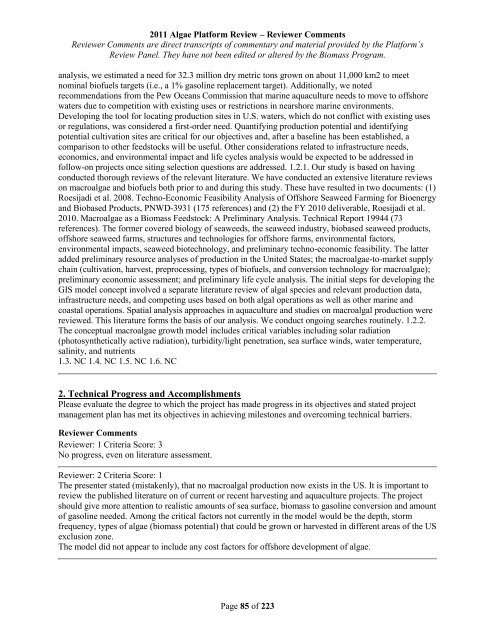Reviewer Comments - EERE
Reviewer Comments - EERE
Reviewer Comments - EERE
You also want an ePaper? Increase the reach of your titles
YUMPU automatically turns print PDFs into web optimized ePapers that Google loves.
2011 Algae Platform Review – <strong>Reviewer</strong> <strong>Comments</strong><br />
<strong>Reviewer</strong> <strong>Comments</strong> are direct transcripts of commentary and material provided by the Platform’s<br />
Review Panel. They have not been edited or altered by the Biomass Program.<br />
analysis, we estimated a need for 32.3 million dry metric tons grown on about 11,000 km2 to meet<br />
nominal biofuels targets (i.e., a 1% gasoline replacement target). Additionally, we noted<br />
recommendations from the Pew Oceans Commission that marine aquaculture needs to move to offshore<br />
waters due to competition with existing uses or restrictions in nearshore marine environments.<br />
Developing the tool for locating production sites in U.S. waters, which do not conflict with existing uses<br />
or regulations, was considered a first-order need. Quantifying production potential and identifying<br />
potential cultivation sites are critical for our objectives and, after a baseline has been established, a<br />
comparison to other feedstocks will be useful. Other considerations related to infrastructure needs,<br />
economics, and environmental impact and life cycles analysis would be expected to be addressed in<br />
follow-on projects once siting selection questions are addressed. 1.2.1. Our study is based on having<br />
conducted thorough reviews of the relevant literature. We have conducted an extensive literature reviews<br />
on macroalgae and biofuels both prior to and during this study. These have resulted in two documents: (1)<br />
Roesijadi et al. 2008. Techno-Economic Feasibility Analysis of Offshore Seaweed Farming for Bioenergy<br />
and Biobased Products, PNWD-3931 (175 references) and (2) the FY 2010 deliverable, Roesijadi et al.<br />
2010. Macroalgae as a Biomass Feedstock: A Preliminary Analysis. Technical Report 19944 (73<br />
references). The former covered biology of seaweeds, the seaweed industry, biobased seaweed products,<br />
offshore seaweed farms, structures and technologies for offshore farms, environmental factors,<br />
environmental impacts, seaweed biotechnology, and preliminary techno-economic feasibility. The latter<br />
added preliminary resource analyses of production in the United States; the macroalgae-to-market supply<br />
chain (cultivation, harvest, preprocessing, types of biofuels, and conversion technology for macroalgae);<br />
preliminary economic assessment; and preliminary life cycle analysis. The initial steps for developing the<br />
GIS model concept involved a separate literature review of algal species and relevant production data,<br />
infrastructure needs, and competing uses based on both algal operations as well as other marine and<br />
coastal operations. Spatial analysis approaches in aquaculture and studies on macroalgal production were<br />
reviewed. This literature forms the basis of our analysis. We conduct ongoing searches routinely. 1.2.2.<br />
The conceptual macroalgae growth model includes critical variables including solar radiation<br />
(photosynthetically active radiation), turbidity/light penetration, sea surface winds, water temperature,<br />
salinity, and nutrients<br />
1.3. NC 1.4. NC 1.5. NC 1.6. NC<br />
2. Technical Progress and Accomplishments<br />
Please evaluate the degree to which the project has made progress in its objectives and stated project<br />
management plan has met its objectives in achieving milestones and overcoming technical barriers.<br />
<strong>Reviewer</strong> <strong>Comments</strong><br />
<strong>Reviewer</strong>: 1 Criteria Score: 3<br />
No progress, even on literature assessment.<br />
<strong>Reviewer</strong>: 2 Criteria Score: 1<br />
The presenter stated (mistakenly), that no macroalgal production now exists in the US. It is important to<br />
review the published literature on of current or recent harvesting and aquaculture projects. The project<br />
should give more attention to realistic amounts of sea surface, biomass to gasoline conversion and amount<br />
of gasoline needed. Among the critical factors not currently in the model would be the depth, storm<br />
frequency, types of algae (biomass potential) that could be grown or harvested in different areas of the US<br />
exclusion zone.<br />
The model did not appear to include any cost factors for offshore development of algae.<br />
Page 85 of 223




